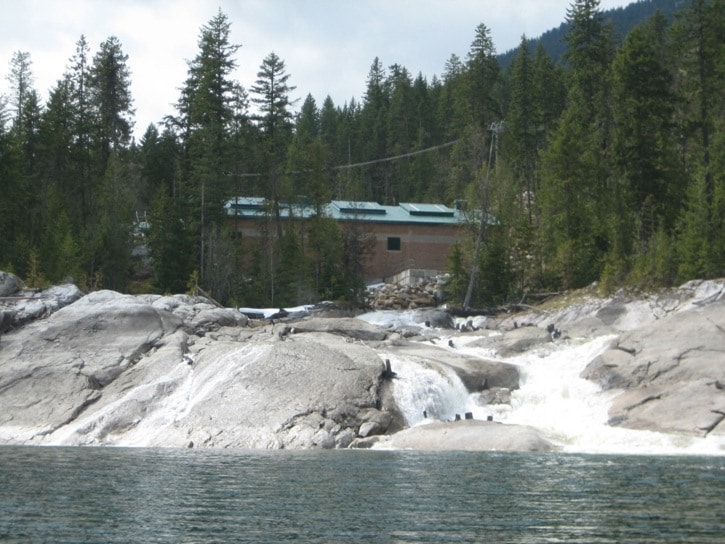By Michael Watson
In the August 8 edition of the Revelstoke Times Review you couldn’t help but notice the 12 Intentions to Apply for an Investigative License on Crown Land for run-of-river projects. The sheer number of intentions, which took up almost seven pages in the classifieds, represents the mismanagement of our creeks and rivers. While these types of notices are new due to recently policy changes they still mark the beginning for these projects to become a reality.
I have visited a majority of the proposed creeks and rivers but some are just too remote to access. Some of the proposals are near existing infrastructure like transmission lines, highways, and logging roads that would lessen the impact compared to the remote ones but the environmental risk is still to great compared to the benefits. The Goldstream River Valley, 90 kilometres north of Revelstoke is home to seven proposals by two private companies. Towards the upper part of the valley Norman Wood Creek, Upper Goldstream River, and Stitt Creek all have proposals on them and if built all three powerhouses would be within one kilometre of each other. This is just another example of mismanagement and poor planning associated with the Independent Power Producer program.
The way these projects are evaluated are on a one-off style of criteria and there is no cumulative impact studies done in relation to separate nearby projects or on a whole for the province. Run-of-river (more along the line of river diversion) projects are not new but the technology has come a long way. However, there have been no scientific studies done on the ecological effects of these run-of-river projects. A new publication out of UBC about BC’s Inland Rainforest highlights the concerns about run-of-river projects specifically near Revelstoke. It outlines concerns due to the reduction of aquatic invertebrate production even if fish habitat is not compromised. Also the effects associated with the rise of water and creek bed temperatures within the area where the creek or river has been diverted are still not known. Compound these with the reduction of spray zones around waterfalls, within the diversion reach, which create unique humid environments that promote a high diversity of lichens and other plants. The environmental effects are uncertain and clearly more research is needed.
In my opinion the negatives outnumber the positives for the Independent Power Producers (IPP) program. Crown land tenures are given to private power companies, the company alters the watershed forever for what it calls ‘green’ energy, the projects receives lucrative payments from BC Hydro to produce the power (Currently BC Hydro owes $35 Billion in outstanding IPP contracts). There is little government oversight of the projects due to budget cuts, and add that to the fact that the power comes mostly in spring – when BC Hydro’s reservoirs are filled to the brim.
Recently the government has altered the process and mandates associated with IPPs, as mentioned in last week’s article. The fact that the current government wishes to supply the new LNG processing plants with IPP electricity is asinine. The industrialization of hundreds of creeks and rivers in British Columbia for the perpetration of a fossil fuel industry is not in the best interest of British Columbians. We will bear the brunt of the costs for this expensive IPP electricity as ratepayers. Also, where will the electricity come during the winter months when the run-of-river projects are running at their lowest? These band-aid style solutions with no long-term planning continues to bankrupt BC Hydro and will end the era for one of the most profitable Crown corporations in Canada.
Private companies wanting to industrialize B.C.’s creeks and rivers are strictly profit driven and would have no interest in conservation approaches; the more water that flows the more money being made. There has also been major malfunctions with IPP run-of-river projects and were brought to light in a FOI request by the Wilderness Committee earlier in the year.
In some cases creeks and rivers have run dry for days due to problems with the intake structure, and also stranding and killing fish. One of those mishaps was at the Akolkolex River facility just south of Revelstoke in 2005 where water was not observed for three days in the diversion reach. The cause was faulty equipment resulting in an excess of energy being produced. This is not acceptable and once again highlights the failings associated with run-of-river projects and the IPP program.
We are experiencing a gold rush mentality on our precious natural resources with the current provincial government over the last ten years. We as British Columbians must continue to speak up about this ‘bullish’ mentality that everything has a dollar value. Not all run-of-river style projects are bad but the way they are managed benefits private interests and not ratepayers. Let’s do green energy right.
Michael Watson has been active in the IPP run-of-river debate since 2009 and Chairs the North Columbia Environmental Society IPP Committee
